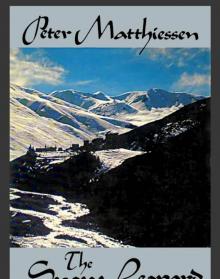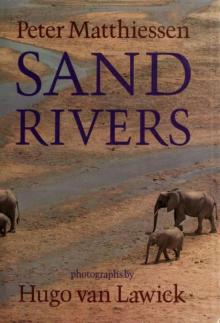- Home
- Peter Matthiessen
The Cloud Forest Page 3
The Cloud Forest Read online
Page 3
December 5–7. Barbados.
The island of Barbados, where the ship called for three days after our departure from Saint Lucia and before proceeding to Saint Vincent, lies one hundred miles or so out to the eastward of the Windward Islands. Like Bermuda—and unlike the Windwards, which are peaks of a submerged mountain range—it is a true oceanic island, surrounded by a fringing reef of coral, and more or less unrelated, geologically, to the mainland. Its countryside, patched by canefields, is low and rolling for the most part, with small spare farm communities and pretty churches and roadside trees bent permanently by the trades. When the sea drops out of sight, the landscape brings to mind certain areas in our Plains States, the sugarcane mills standing up out of dry distances like grain elevators in North Dakota, say, on a long, blue afternoon of summer.
December 10. Trinidad.
Arrived in Port-of-Spain last night, coming south from Grenada through the cut between Trinidad and the Paria Peninsula of Venezuela, known as the Dragon’s Mouth. A gray day, the first in a long time, and rather welcome. The anchorage is wide, with boats in black silhouette littered out across the dull sheen of it as far as the eye can see. This is not very far today. Laughing gulls, winging up and down.
Its name, Port-of-Spain, is the prettiest aspect of this great dirty town which, according to the port pilot, sees more shipping tonnage come and go than Liverpool. It has a kind of tarnished modernity about it, a fly-by-night air, like an abandoned fair invaded by a pack of gypsies, and it has that terrible sweet smell common to all towns in these latitudes, one which I’ve found impossible to track down. The smell has now invaded the ship itself, like some sort of pervasive melancholia; it loiters in the vicinity of the galley. I’m told that the island of Trinidad is beautiful and am quite ready to believe it, but I have a very poor impression of its capital. It seems appropriate that, throughout this long listless day, a squadron of vultures swept up and down on the city’s damp, stagnant airs.
The name of the place, as I recall from the days when I collected stamps, is actually Trinidad-and-Tobago. The latter is a much smaller island off to the northeast, and, having rounded the cape to the north again, we left it astern at eight a.m. the following morning, headed southeast for Georgetown, British Guiana. We are off the many mouths of the Orinoco, and the water is discolored. A frigate bird, a distant booby, and two black-backed, white-bellied shearwaters, unidentifiable—conceivably the lost diablotin, but in all probability Audubon’s shearwater.
December 12. British Guiana.
We are now in green coastal waters, silky and turgid, but the low land is invisible. In midday the screws of the Venimos churn up great gouts of brown sand as we ease over a bar, for here the continental shelf, built up by the numerous rivers, is very broad and shallow.
One-thirty p.m., and South America now in sight, a low black line in the sunny mist. Royal terns and laughing gulls, both familiar birds at home, are the first signs of its wildlife. An hour later we enter the Demerara River, with Georgetown to port, its long quays banked with freighters. There is the Kronos, a hard-looking rusty craft, black and copper-orange, out of Monrovia, and the green Ankaka out of Liverpool, its taffrail crowded with grimy seamen. One old big-backed tub of guts lets fly his spit in our direction; he owns, on closer inspection, the meanest face I have seen in many months, and he has with him the usual thin acolyte, smirking and agitating. Long black skiffs careen up and down the river’s muddy chop, powered by outboards, tall raucous Negroes upright in their sterns.
On the warehouse roof perches a bird, bright-yellow-bellied. This is the bienteveo tyrant, a large flycatcher—my first wild creature indigenous to South America.
2
Amazonas
SURINAM, PARAMARIBO, SINNAMARIE, Cayenne: small mountains rise behind the flat mud coasts of the Guianas, and small islands fleck a horizon of humid clouds. One of these is the infamous Devil’s Island, now a beacon. Off Cayenne, at the edge of Brazilian waters, out of sight of land, a strange lugger drops its sail in signal, and the ship veers sluggishly to investigate. But as we draw near the craft makes off erratically—she has signaled us by mistake. A smuggler, apparently, one of a fleet of midnight traders which serve Brazil’s huge appetite for contraband.
Our ship is British, and austerely we pass on. The Venimos is nearly a month out, and her cargo is reduced to a small tractor for Belém, oil machinery for Manaus, and shotguns, rifles, and storage batteries for the terminal port of Iquitos in Peru—these in addition to her regular consignment of general goods and foodstuffs, most of which (including a shipment of Christmas trees for the Windward Islands) has now been left behind. She is all but hollow, and she rides high on the olive waters of this forlorn coast, beating southeast against the North Equatorial Current. To the west, just over a dull skyline, lies the wild region of the Araguarí River.
December 18.
The equator is crossed during the night, and at dawn, off the village of Salinas, the pilot comes aboard. Now we are bearing west again, the rising sun directly astern, and ahead a morass of shifting currents, tides—mud, green, gray, and silver—at odds beneath the broken clouds like unmixed paints. The Amazon, and a strange species of tropic tern, strikingly marked across the mantle. Far off, on both sides, small porpoises ease lazily along. A few fishing sloops break the expanse, lateen-rigged, rakish hulls blue beneath rare-colored sails of pink, copper, aquamarine. The jungle, dark, indecipherable patches on the horizon, is too distant to feel as yet, though Marajó Island is rising on the starboard bow, and the river is thickening with sediment. This is the Pará Estuary, the southernmost of the mouths, on which lies the river’s important city, A Cidade de Nossa Senhora do Belém do Grão Pará—the Pará of former days, now called Belém, which, in Portuguese, is Bethlehem.
As the morning changes the clouds swell, and a horizon of countless islands and inlets, though still far away, moves forward slowly to surround us. Small settlements rise and sink again into the jungle, and shortly after noon Belém itself appears, gleaming heavily in the hot mist. Ancient river boats and other craft litter its outskirts which, half overgrown, creep out along the river bank, and here the ship anchors for customs inspection, east of the main town.
Customs at Belém is a famous joke, for the town depends on contraband for its economy, and the customs officials themselves expect neither more nor less than their fair share. Agreeable fellows, well turned out, they swarm aboard in numbers and a little while later go away again with the booty of cigarettes, whisky, and others items which have been set aside for them. They move on, gay as birds, to the next ship into port, a freighter which has gained on our slow wake all morning. Customs takes place out in the anchorage. When the ship ties up at last along the quay the officials happen to be elsewhere, and the crewmen and most of the officers move their wares ashore. One simple mariner has brought from New York four new transistor phonographs; the profit he will make on these will more than match his salary for the voyage.
“In this town,” an inhabitant told me later, “everything is against the law and everything is permitted. If a policeman asks you for a license or a paper, ask him for his authority to ask. He hasn’t any.” We were sitting in a street café, and while this man spoke I absorbed the effect of the cobbled streets and quasi-modern buildings, less like Lisbon than like downtown Madrid. Belém is clean and cheerful, though its waterfront has the seaport complement of paupers and prodigious rats, and everywhere the gray-headed urubu, or black vulture, hunching and hopping through the litter on its pale legs, or picking silently at the refuse on the tideline. Across the Pará stand the jungle islands, and one has a deep sense of the smallness of Belém, of the hugeness which lies all around it and beyond.
While in port I paid a visit to the Belém zoo and botanical gardens, a joint establishment which has had the excellent idea of confining itself to the flora and fauna of the Amazon, rather than presenting the usual small-zoo grab-bag of rhesus monkeys, over-age circus animals, and exiled
pets. The visit afforded some sort of protection against that flood of misinformation in regard to the Amazon and its wildlife which somehow befits the region’s titanic aspects.
Amazonas, as the whole basin is sometimes called, includes large areas of four countries, though the great part of it is in Brazil; in the extent of its unknowns it might be compared to western North America of the early nineteenth century. In places the land behind the river banks is unexplored, and lost cities, lost tribes, and strange animals may still be discovered. This much is true, and exciting enough too, but even so, an immense store of legends has been propagated throughout the centuries, ever since Francisco de Orellana, in 1541, first reported the existence of fierce female warriors in the region of Óbidos. The legends are augmented at every opportunity, not only by the Indians and settlers, but by the adventurers of all nations who drift in and out of the towns on this huge frontier, and by incautious writers like myself who venture within hearing distance.
In four hundred years the river has changed little; its violent wilderness and the potentially lethal elements in its fauna have remained largely intact. The waters of Amazonas harbor large crocodilians of the group known as caimans, the mighty river boa or anaconda, two species of puraque or electric eel, sting rays, the notorious piranha, and a sliver-like little fish of wretched bent called the candiru, which seeks out even the smallest orifices of the body and lodges itself with its spines; once implanted, it has to be cut out. Land animals include the jaguar and a variety of poisonous snakes, among which the great sucurucu, or bushmaster, and the jararaca, or fer-de-lance, are perhaps best known; there are also tarantulas, scorpions, and a host of stinging ants and other insects. Biting flies, mosquitoes, and hornets are among the aggressive insects of the air, and this element can boast, as well, the common vampire bat.
Beriberi, malaria, leprosy, and blackwater fever are among the many diseases which do well here, and there are still hostile Indians; to read or listen to most accounts of Amazonas is to conclude that only a maniac would ever set foot out of doors. The truth, which is something else again, is obscured by the fact that, in this country of unknowns, the legends are not only not readily disproved but are even occasionally confirmed. Finally, it is very difficult not to defer to an apparently honest man who has been in the wilderness, when you and your whole gang of pale authorities have not.
In Belém, for example, I fell in with a French Canadian who may as well be called Picquet. He is a lean, neat man, an ex-house-painter and merchant seaman, semi-educated, who carries with him everything he owns—the clothes on his back, a jackknife, a safety razor with a sawed-off handle which fits into a small wood matchbox, and a waterproof packet containing his passport, billfold, and set of worn maps on which he has traced his journeys through South America. When I met him he was weak with recurrent malaria, and broke, but had arranged with one of the contraband boats to take him as far as Paramaribo, in Surinam, where he hoped to find work on a freighter bound for Europe.
Picquet arrived on this continent three years ago, traveling alone and on foot, with a shotgun and two compasses, down through the trackless jungles between the Canal Zone and central Colombia (this is the wild area where a long gap still exists in the Pan-American Highway); since then he has walked, worked, and hitchhiked his way through every country but Paraguay. I could find no flaw in his accounts, nor any real reason to doubt him. (“I don’t have to make up stories,” he remarked at one point, “because nobody would believe what I actually have seen, anyway; I’ve seen too much.” He said this with polite indifference to my opinion, and perhaps that is the charm of the world’s Picquets—that catlike and quiet indifference, even to those who, as in my case, were paying for his beer. This trait is a peculiarity of wanderers, so familiar that I felt I must have crossed paths with Picquet before, in the deserts of the West, perhaps, or in Alaska. It’s a disturbing quality, and one that induces a certain self-consciousness about one’s glasses, say, or the gleam of one’s new khaki pants.) For most of what he recounted, consciously or otherwise, he supplied a ready means of checking up on his story and, with a restraint rare in these parts, he actually belittled the dangerous nature of jungle creatures: he admitted that poisonous snakes and other animals were a menace under special circumstances, but, in his opinion, the only one which, unprovoked, might attack and kill a man was the anaconda. I had mixed feelings when he succumbed at last and described a rare striped cat not quite so large as a jaguar and very timid, which is possessed of two very large protruding teeth: this animal, he said, occurs in the mountain jungles of Colombia and Ecuador, and he has glimpsed it once himself. (No such cat is known, of course, but one great asset such stories bear with them is the pathetic eagerness of listeners like myself to rationalize them. Let’s suppose, I exulted, that the saber-toothed tiger, like the cougar, had long ago established itself here in a smaller subspecies and had thus survived the Ice Age extinction of its North American ancestor; what are the llama, vicuña, and guanaco, after all, but living descendants of cameloid animals which became extinct on the northern continent? For one wild moment, propped up by my own zoological jargon, I teetered on the brink of great discovery.) I believe Picquet was sincere in his account, however mistaken, though the matter did not seem to concern him much one way or the other. He went on to describe how he and another seaman had fallen overboard from their freighter during World War II, when a deck cargo of lumber shifted in heavy seas off Trinidad—and here again, curiously, he happened to mention the name of the American destroyer which retrieved him eight hours later, so that this story, like most of the rest, could readily be traced. He believes he has a charmed life, and has since put it to the test all across the world. “I can’t sit still,” he said, and this was quite literally true; his sad eyes were never really with me, even when he was talking with animation. “I figure I have thirteen lives”—he did not bother to explain this—“and have used up about seven. That leaves me six to go.” I nodded, expecting him to say that when he reached number twelve he would stop wandering and go home. He didn’t, though. “When I get to number thirteen,” he said, “I’ll die.”
The ship sailed at two in the morning, to take advantage of the tides, and at daybreak we were well beyond the mouth of the Tocantins River. To the north rose Marajó Island, which sits in the mouth of the Amazon like a huge cork. Though the Pará is wide here, the channels are treacherous and narrow; on Mandihoy Bank, which boasts the sole navigation light in all the thousands of miles of river, the hulks of two sunken vessels protrude like black and rotten stumps.
The jungle is remote, rather ominous, on every side. An occasional white egret, like a speck caught on the distant walls of green, the yellow-billed river terns coursing the brown wake for tumbled minnows, and far, floating urubus—these are the only life.
The merchant and the missionary left the ship at Belém, and I shall miss them. They have been replaced by an elderly Dutch lady and five Dutch Catholic missionaries, one of whom shares my cabin. Today he is suffering from dysentery and lies miserably in his berth. He is fortunate that illness overtook him here, where he can be tended, for his mission lies six hundred miles upriver from Manaus and the nearest doctor. To expedite their good works, the missionaries have with them a small cabin cruiser, which was hoisted onto the foredeck at Belém: their roadless parishes are huge, the area administered by my cabin-mate alone being larger than all of Holland.
This idea is more startling to me than the familiar statistics on Amazonas—that the basin alone is nearly as large as the continental United States, more than two million square miles, and contains one-fifth of all river waters on the earth, that Marajó Island in its mouth is larger than Switzerland, that the river empties more than twelve times as much water as the Mississippi and carries annually five billion tons of sediment into the sea, where it muddies the water either one hundred or two hundred miles from the coast, depending on the writer. Such figures are impressive, surely, but they seem rather empty whe
n removed from the context of human endeavor; the 238,857 miles to the moon, for example, is a much more awesome distance now that the possibility exists that man, a particular man, will traverse it.
Besides, awe of the Amazon is emotional, not intellectual. H. M. Tomlinson, whose The Sea and the Jungle is one of the few level-headed works in the literature of this region, quotes a description of the implacable “waiting” of the jungle:
I’m half afraid of it … not afraid of anything I can see … I don’t know. There’s something damn strange about it. Something you never can find out. It’s something that’s been here since the beginning, and it’s too big and strong for us. It waits its time. I can feel it now. Look at those palm trees, outside. Don’t they look as if they’re waiting? What are they waiting for? You get that feeling here in the afternoon when you can’t get air, and the rain clouds are banking up around the woods, and nothing moves.
This concept is accurate and difficult to improve upon. There is a deadness in the air in this terrific heat of the equator, and a sky neither quite shining nor quite raining, but poised between the two, a silver sky of dirty bruises, of suspense. (But later in the day the sky turned a pale blue, and later still an explosion of wind out of the north, the vente gerol, burst the humidity apart. Suddenly, more suddenly than in any change of weather I have known, the air was chill. For the first time since the ship left Bermuda I considered putting on a sweater. And night along the Amazon is cool.)
So … there is something strange in these jungle airs, no doubt about it, something of foreboding. Man seems ill at ease here. On the bank there is a palm hut, it is true, and an occasional rude clearing, but these are impermanent, as if tacked on the green wall, and the huts in any case will go when the river rises. The rainy season has begun, and already great patches of live savanna grass and whole dead trees drift swiftly eastward. The banks are low on this stretch of the river, and the jungle is never cleared, only bent back. The huts on the higher banks boast a few plantains and occasionally some scraggy, humped gray cattle; these are nomadic settlements of loggers, cutting macaca uba, andiroba, sucupira, and others of the myriad tropic hardwoods. Some of the settlers—the forest halfbreeds, copper-colored, are called caboclos—produce manioc and jute, and some tap the wild rubber trees, the seringueiras, but most come and go with the river level, subsisting on wild fruits and animals and the river’s swarming fish. A frail, small canoe beneath the jungle wall is more forlorn than a solitary sail at sea.

 Lost Man's River: Shadow Country Trilogy
Lost Man's River: Shadow Country Trilogy The Tree Where Man Was Born
The Tree Where Man Was Born The Snow leopard
The Snow leopard Sand Rivers
Sand Rivers The Cloud Forest
The Cloud Forest Sal Si Puedes (Escape if You Can)
Sal Si Puedes (Escape if You Can) Far Tortuga
Far Tortuga Men's Lives
Men's Lives On the River Styx: And Other Stories
On the River Styx: And Other Stories Shadow Country
Shadow Country At Play in the Fields of the Lord
At Play in the Fields of the Lord Lost Man's River
Lost Man's River Killing Mister Watson
Killing Mister Watson On the River Styx
On the River Styx